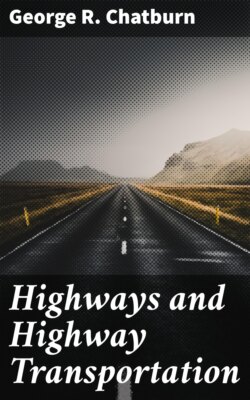Читать книгу Highways and Highway Transportation - George R. Chatburn - Страница 49
На сайте Литреса книга снята с продажи.
National Participation.
ОглавлениеTable of Contents
—The Revolutionary War had shown the need of roadways for quick intercourse between the seaboard and the trans-Alleghany regions. The efforts of the different states, still retaining their colonial jealousies, to secure the control of the trade of these regions emphasized the need of a unifying influence which would bring harmony. The debate proceeded in a desultory fashion for a number of years. Strict constitutionalists did not believe the national government has the authority to construct roads at all. States’ rights men argued that road construction is the province of the states and the National Government has jurisdiction only in the territories. On March 29, 1806, President Thomas Jefferson approved a bill to survey and construct a road from a point on the Potomac near Cumberland to the Ohio River near Steubenville popularly known as the Cumberland or National road, and appropriated therefor $30,000. This was in the minds of friends of government control to be the beginning; there was increasing need of travel and traffic facilities from the Hudson to the Great Lakes, from the Delaware to the Ohio; from Virginia and the Carolinas to Kentucky and Tennessee, to say nothing of north and south routes, which unfortunately did not mature in time to prevent the great Civil War a half-century later.
Alfred Gallatin and Henry Clay sponsored the Cumberland Road. The former in compliance with the wish of Congress (1808) drew up a scheme for a national system of internal improvements by roads and canals at an annual expense of $2,000,000 for ten years. But its opponents were able to stay it off and the war of 1812 coming on caused financial troubles and the entire scheme was indefinitely postponed.
The first appropriation for the Cumberland Road had been made, not from the general funds of the government, but from the proceeds of the sales of land, a fiction, of course, for the benefit of the strict constitutionalists. Gradually, however, Congress came to accept the doctrine of “implied powers.” Madison in his last message invited the attention of Congress “to the expediency of exercising their existing powers and, where necessary, of resorting to the prescribed mode of enlarging them, in order to effectuate a comprehensive system of roads and canals, such as will have the effect of drawing more closely together every part of the country, by promoting intercourse and improvements and by increasing the share of every part of the common stock of national prosperity.”[40]
Up to this time there had been completed only 23 miles of the road. In 1816, $300,000 was appropriated for its completion; two years later $260,000 was voted; but a proposal to appropriate $600,000 for internal improvements failed in 1817, as did also a bill providing for the extension of the Cumberland Road. But as a result of the labor of Henry Clay, Albert Gallatin, Thomas Jefferson, President James Madison, and other friends of cheap and rapid transit, by 1820 the total of Congressional appropriations for the Cumberland Road amounted to more than $1,500,000; in 1844 the thirty-fourth appropriation made a total of nearly $7,000,000.[41] The growth of the road was slow: the first contract was let in 1811 for 10 miles; contracts for short sections were let from year to year and the road by 1817 had crawled, following approximately the Nemacolin Path, with the Potomac through the Cumberland gateway over the Alleghany range by way of Negro Mountain at an elevation of 2325 feet, down to the Youghiogheny, past the scene of Braddock’s defeat and the cairn which marks his resting place, through the Laurel Hill Range over to Brownsville within reach of Pittsburgh, thence westward slightly north through Washington (Pennsylvania), to Wheeling (West Virginia) on the Ohio River.
Thus had the old Indian trail developed into a route for Washington and his band to Fort Necessity; into Braddock’s road to Great Meadows; into a pack train trail trampled by thousands of caravan hoofs; and, finally, into a finished paved highway cleared to 66 feet in width, having no grade above 5 per cent which Washington and Jefferson and Madison had visions would be the means of binding together with the strong bands of commerce the cis- and trans-Alleghanian countries.
